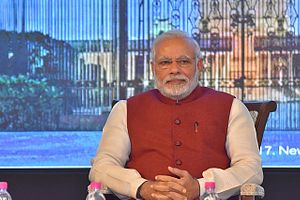In the western Indian state of Rajasthan, the pre-monsoon dust particles rose up in a frenzy, to prepare for Prime Minister’s Narendra Modi’s visit to the state capital of Jaipur on July 7. A helipad was built at the tennis court of the Sawai Man Singh stadium to facilitate the landing of the helicopter in which he would arrive; non-sports activities there had been put to a halt by the Rajasthan High Court nearly two decades ago.
A week ahead, local newspapers filled pages with details of the security plan. Reportedly 250,000 people – “scheme beneficiaries” – from across 33 districts of this large state were to be brought in by 5,579 buses.
Few newspapers detailed who would be picking the tab for welcoming Modi: the cost of ferrying in people alone cost more than $1 million. The day of the event saw traffic diverted; Modi was to speak at a large ground in the middle of the city, connected by the city’s arterial roads. Nobody was to be seen wearing black. The ruling Bharatiya Janata Party (BJP) had faced embarrassment during Modi’s visit to the state in March this year, when protesters had raised black flags. Eight of them were arrested.
This time, the tight security meant that even black handbags or scarves carried by women were lying strewn before the entrance. The only black that people could enter with was their hair.
Modi arrived precisely on time – at 1:15 p.m. Minutes prior, the woman emcee compared him to the winged carrier of ideas and dreams, as well as Mahavir, Buddha and Vivekananda. She urged the audience to cheer for him, to let it be known how his schemes had benefited hundreds of thousands. A weary crowd, sitting under the large tent, and watching the proceedings of the stage far-off on large screens, wore colored sashes. Every color was coded to reflect every scheme that had been introduced in the state. Every large block under the tent was marked by these colors – an efficient form of managing the bus-loads of people, most of them unlettered.
Rajasthan Chief Minister Vasundhara Raje, who held the same post from 2003 to 2008, and returned to power in 2013, did not lose minutes in critiquing the erstwhile Congress government. The criticism segued into detailing the way in which the BJP government had delivered 12 developmental schemes “without any leakage” of funds.
To drive home how these would change the lives of people in Rajasthan, Raje introduced each of the previously introduced schemes, one by one. Short videos featured one beneficiary story each, claiming that in all, the schemes had benefited nine million people from the state.
Modi began his speech invoking the land of the mighty and the brave, the land of colorful turbans, sweet language, lyrical music. “But we all know how the previous government left Rajasthan in shambles; do not forget that,” he urged, even as the hired crowd began to make their way out of the tents. He announced 13 more urban infrastructure projects for the state, with a budget of $307 million.
“We have just one agenda: vikaas. vikaas, vikaas (development, development, development)…. I urge all the beneficiaries here to go out and tell others to come forth and benefit from all that we have done.” Several of the 250,000 “beneficiaries” who were brought to Jaipur hadn’t benefited from even a single scheme.
What does it mean when a crowd has to be urged to cheer and clap? It means that the hired audience is bored, and may not be too keen to bite the bait of new schemes, strategically announced before elections.

































